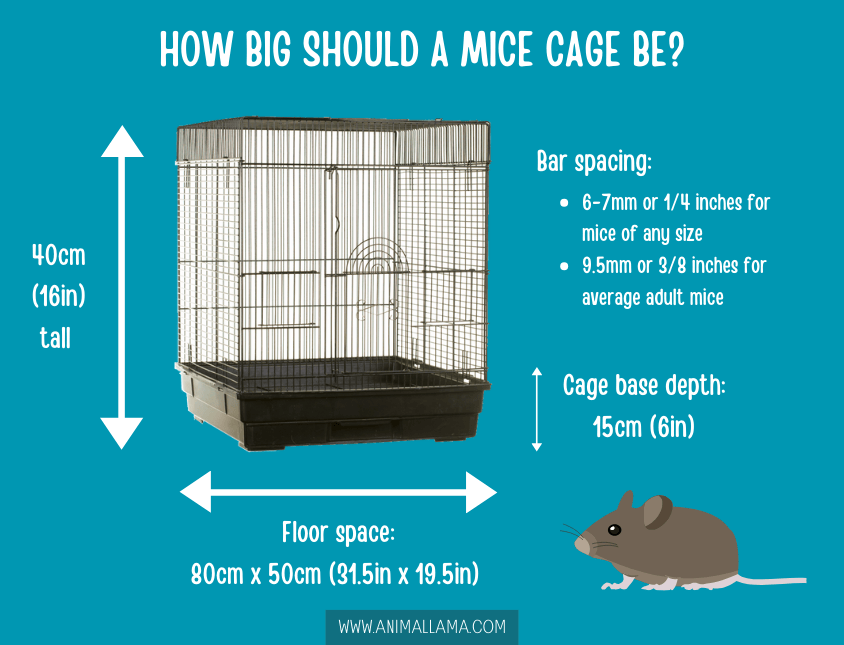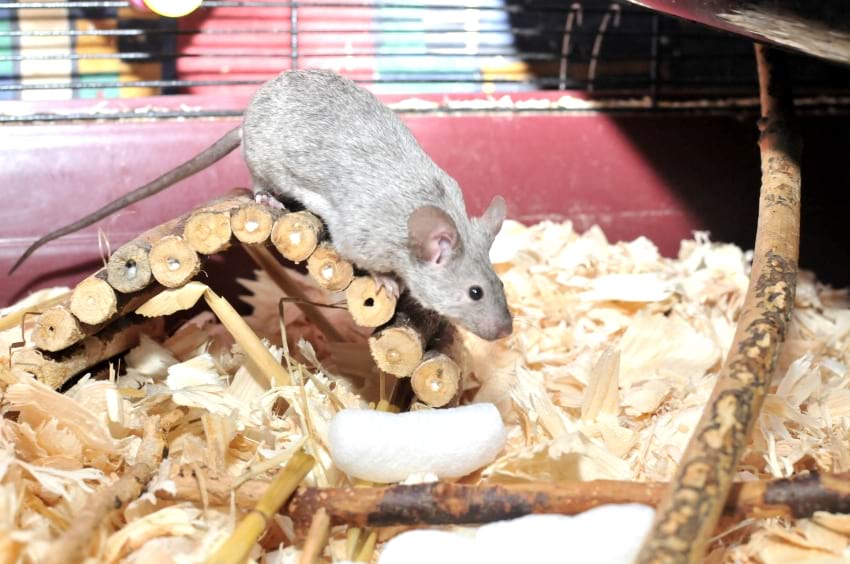Before bringing your new friends home, it’s crucial to ensure you have all the necessary equipment to take care of them. One of the most important things to consider is purchasing a suitable cage. Here are some factors to keep in mind when it comes to mice cage requirements.
This article was coauthored by Beri Instone, a responsible mouse breeder, and Alison’s mouse expert.
How Big Should a Mouse Cage Be?
Since most pet mice spend the majority of their time in their cage, it needs to be large enough to serve as a complete environment for them. The cage should have enough space and furnishings to allow the animals to express all their natural behaviors without becoming stressed.
Fortunately, there is a wide selection of cages available for mice owners today compared to a decade or two ago. This means that a lot of the advice found in care books and older internet sites may be outdated, as it was based on a time when small cages and tanks were the only options. Nowadays, many pet care brands offer large cages with suitable bar spacing for mice, and with some thorough online searching, you can find a cage that meets your needs without compromising on the health and quality of life of your mice.
To determine the size of the cage you need, you can use a rat cage calculator and double the number of animals to get an idea of how many mice it can accommodate. For instance, a cage suitable for around 4 rats can comfortably house around 8 mice.

The shape of the cage is also important. Mice love to burrow and dig in their substrate, so the cage should have a good size footprint of at least 80 x 50 cm / 31.5 x 19.5 inches, with a deep base tub to hold a thick layer of substrate.
Additionally, mice need to climb, so the cage shouldn’t be too low – a minimum height of 40 cm / 16 inches is ideal for a mouse cage.
What Size Bar Spacing Should a Mouse Cage Have?
Most cage manufacturers do not explicitly market their cages as designed for mice, so prospective owners need to do some research. Looking for cages advertised for other small animals like dwarf hamsters is a good starting point, although it’s important to note that these animals may have different needs. Some rat cages may also be suitable for larger mice.
Getting the bar spacing right on a cage is essential for keeping pet mice safe, but it can be tricky since mice can vary greatly in size. The weight of an adult mouse typically ranges from 30-45 grams, but healthy adults can weigh anywhere from 24g to 80g depending on their genetic lineage and diet during their youth.
A difference of just 20g in mouse weight can determine whether a cage’s bar spacing is suitable or not, so it’s crucial to weigh your mice using electronic kitchen scales rather than estimating based on their age. If purchasing from a breeder, obtaining information on the weight and size of the rest of the family is also advisable.
When considering bar spacings, remember to measure the actual gap between the bars, as this may differ from the advertised spacing. Most manufacturers provide the distance between the midpoint of two bars, which includes the thickness of the metal bar and may not be as helpful. It’s also important to inspect the entire cage for any areas that may have spaces larger than the bar spacing, such as around doors and at the corners of cage panels.

There are three main categories of bar spacings advertised on cages for very small animals:
- Bar spacing of 6-7 mm (1/4 in): Suitable for mice weighing over about 15g / 0.53 oz (which should include all mice old enough to be sold). Most of these cages are marketed for dwarf hamsters, but some may explicitly mention mice.
- Bar spacing of 9-9.5 mm (3/8 in): The standard bar size on most dwarf hamster cages, suitable for the average adult-sized mouse.
- Bar spacing of 10-12 mm (1/2 inch): Only suitable for very large mice and best avoided as the bars may be weaker, allowing determined mice to escape.
In general, thicker bars are better as thin bars are more flexible and easier for a mouse to push through. It’s important to note that bar thickness may not be consistent even within one manufacturer’s range, so each cage should be evaluated individually.
If you have a well-sized cage with bar spacing that is too large, it is possible to adapt it by covering the bars with 6mm mesh to provide the necessary security. However, the small size of the mesh can make it difficult to attach cage accessories to the bars, hindering the creation of engaging cage setups. While adapting a cage may be a temporary solution, it is advisable to invest in a cage with the appropriate bar spacing for your mice in the long run.
How Deep Should a Mouse Cage Base Be?

Some potential mouse cages may be the right size with suitable bar spacing but lack a deep enough base. Mice require a good layer of substrate for digging and tunneling (which also helps with odors), and as an owner, you want a deep enough base to contain the substrate in the cage and prevent it from being scattered all over your floor.
Ideally, a cage base should be 15 cm (6 inches) deep, although 13-14 cm (5 – 5.5 inches) is also acceptable. Cages with bases that are 8-12 cm (3 – 4.5 inches) deep are less suitable, as they limit digging and increase mess.
Tanks vs. Cages
Given that mice need to be kept secure in an environment that allows for digging, why do we recommend keeping them in a cage rather than a tank?
The primary reason is health. Tanks used to be a common habitat recommended for mice, but that was before the availability of cages with 6mm (1/4 inch) and 9mm (3/8 inch) bar spacing. With a wider range of cage options now available, we can consider the potential drawbacks of each option more thoroughly.
The main issue with plastic or glass tanks is their poor air circulation, as only one side (the roof) is open to the air. Once the tank is filled with toys (many of which will hang from the roof), there is minimal airflow. Airflow is essential for mice because they have sensitive respiratory systems, and their lung tissues can be easily damaged by infection or the buildup of ammonia fumes from urine. Tanks trap these fumes inside, exposing the mice to them and making it harder for owners to detect their accumulation.
Some tanks designed for rodents have a ventilation strip partway down one side, which is better than a tank without it but still provides less airflow than a fully barred cage. These tanks, along with tanks with cage toppers, are primarily intended for gerbils and hamsters, who produce less urine. Mice, on the other hand, produce more urine and benefit from ample ventilation due to their adaptation to a temperate environment.
If you must use a tank to house your mice, it’s best to reduce the number of mice based on the cage’s size. For example, if a cage of that size could accommodate 6 mice, a tank of the same size would only be suitable for three.
What About DIY Cages?

Some owners choose to create DIY cages using plastic storage tubs with mesh panels for ventilation. While these can be suitable options for breeders, it can be challenging to find a tub in the right size and shape to provide enough space and height. Additionally, setting up a good cage layout with DIY cages can be more difficult than with standard cages, and when factoring in all the DIY work, the cost savings may not be significant.
Constructing cages from wooden cabinets or bookshelves is generally not recommended, as mice tend to chew on wood, and the material can absorb their urine.
Cage Access and Cleaning
Most mouse cages can be easily cleaned by dismantling them (consider having a smaller cage or carrier to temporarily house your mice while cleaning the main cage).
However, it’s worth considering the size of the doors. Having a large door on one side or multiple smaller doors makes it easier to reach in for spot cleaning, perform health checks on mice, or arrange the cage setup. If the cage only has smaller doors, some accessories like wheels or branches will need to be placed in the cage while it is disassembled.

